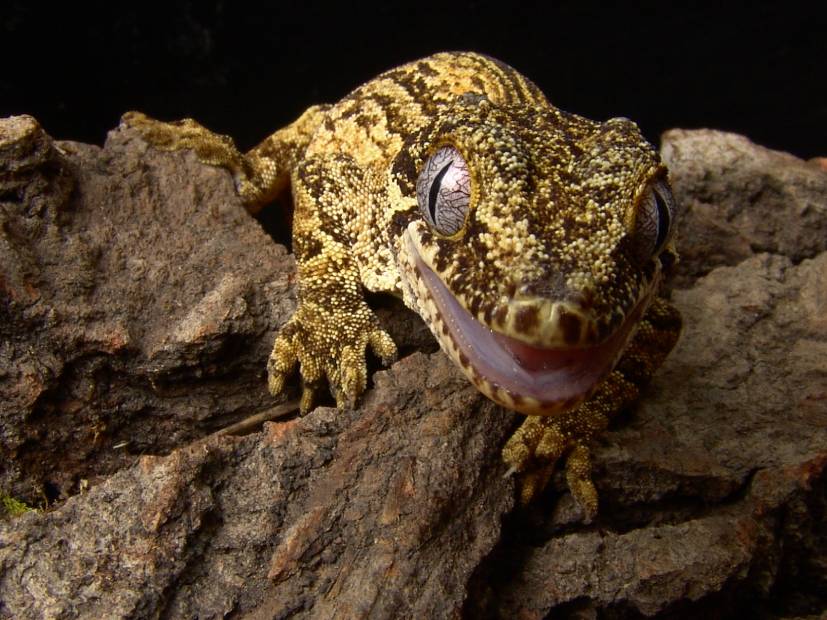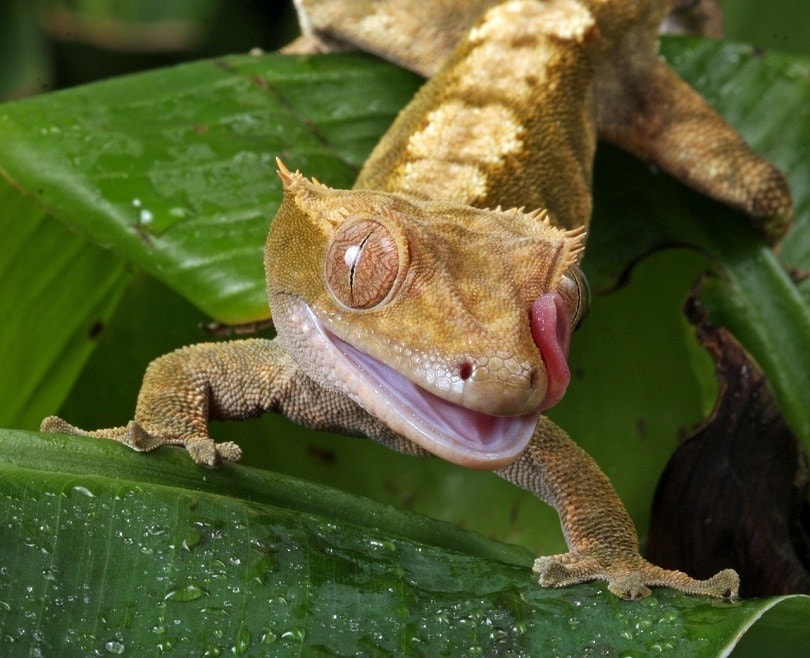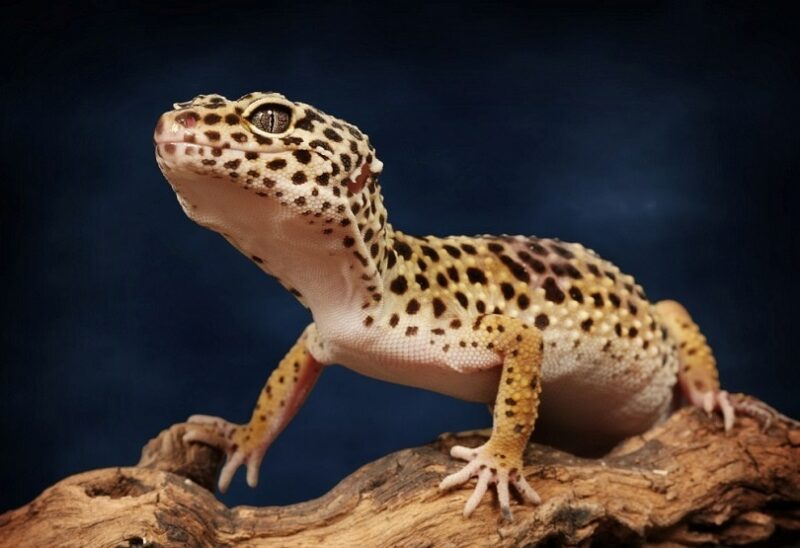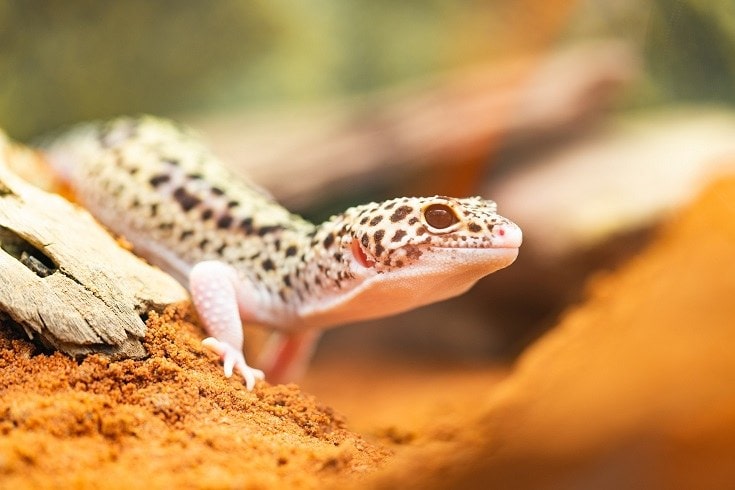
Click Below to Skip Ahead
Have you fallen in love with leopard geckos? Lots of people are, and who can blame them? However, just because these animals are cute doesn’t mean that you should bring one home without knowing how to take care of them, along with the potential diseases that these pets face.
The truth is, leopard geckos can catch certain diseases unique to their bodies if you don’t know what to look for. Caring for a sick gecko is never fun or easy, so why not take the time and learn about common diseases and how to avoid them? Here are 10 common diseases in leopard geckos:
The 10 Most Common Diseases in Leopard Geckos
1. Gout
Gout results from your Gecko’s inability to process uric acid effectively.1 Reptiles eliminate nitrogen from their system through uric acid. But if they can’t flush the uric acid from their body, it builds up in their bodies and surrounds other areas, like the joints and vital organs.
Diets too high in protein, or the wrong kind of protein, can cause gout. Other factors like dehydration, starvation, and predisposing kidney issues can also lead to gout.
2. Dysecdysis
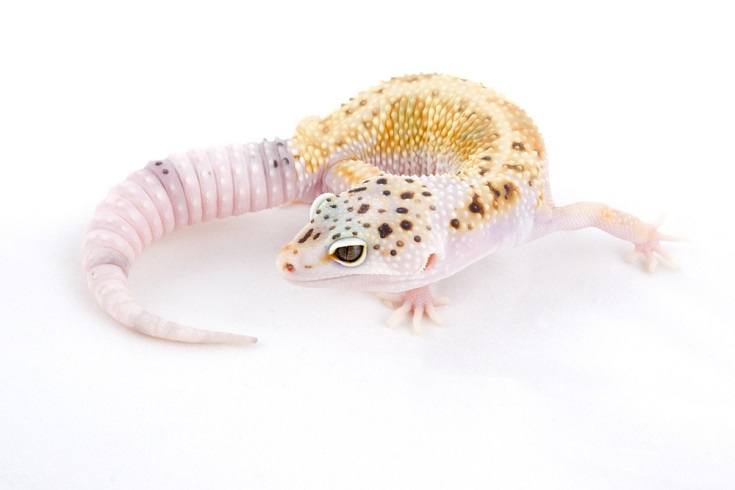
All reptiles shed their skin, but sometimes they can’t shed their skin correctly. When this occurs, you typically notice accumulating skin layers around the eyes and limbs. This is called Dysecdysis. 2
There are a few reasons your gecko isn’t shedding its skin properly. It could be from a lack of humidity in the enclosure or an underlying health issue.
3. Vent Prolapse
A vent prolapse isn’t a disease, but a condition. This is when organs slip out of your Gecko’s vent. These include the cloaca, colon, oviduct (females), hemipenes/phallus (males), or the bladder.
There are several underlying causes for a prolapse. These include egg-laying issues, trauma, inflammatory diseases, infections, kidney diseases and UTIs, cancer, or other metabolic issues.
4. Dystocia
Dystocia, or egg binding, is when a female leopard gecko can’t pass an egg. This can be from illness, poor diet, enlarged or oddly-shaped eggs, pelvic injuries, unsuitable nesting environments, and more.
5. Ophthalmic Disease
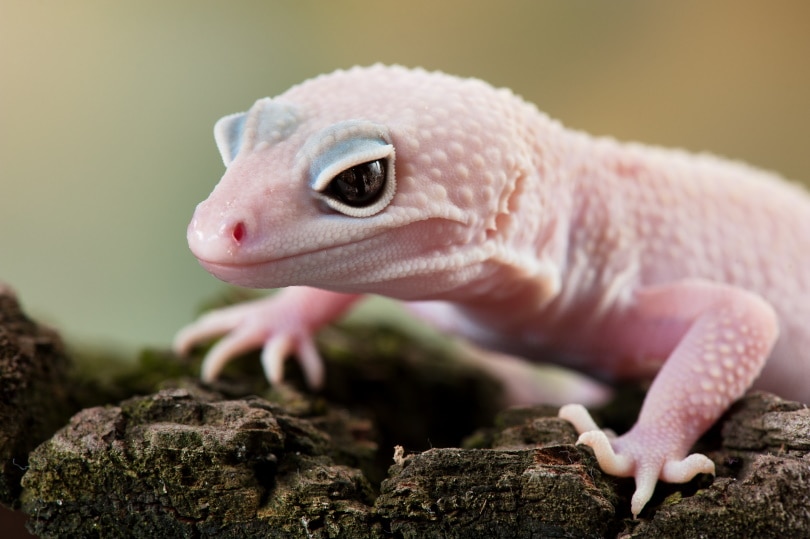
Ophthalmic disease, or eye issues, is a common problem with leopard geckos. The biggest reason is vitamin A deficiency. A lack of a heat source can also lead to eye issues, mainly because cold geckos don’t feed as much and can become malnourished.
Interestingly, a study published in 2018 found that head dysecdysis almost always paired with eye trouble in geckos.
6. Adenoviruses
Geckos are prone to several adenoviruses which may cause fatal digestive tract or liver diseases. Younger Geckos are more susceptible to infection but it can affect adult Geckos.
7. Cryptosporidiosis
Cryptosporidiosis is an infection of the digestive tract caused by various Cryptosporidium species. These are tiny single-celled parasitic organisms. Unfortunately, leopard geckos are the most commonly diagnosed lizard with this infection, and it’s not easy to treat. If you have other leopard geckos, you must quarantine your infected geckos to stop the spread.
The culprit parasite likes to invade the stomach and intestines, so you’ll often see a lack of appetite and an extended belly.
8. Metabolic Bone Disease (MBD)
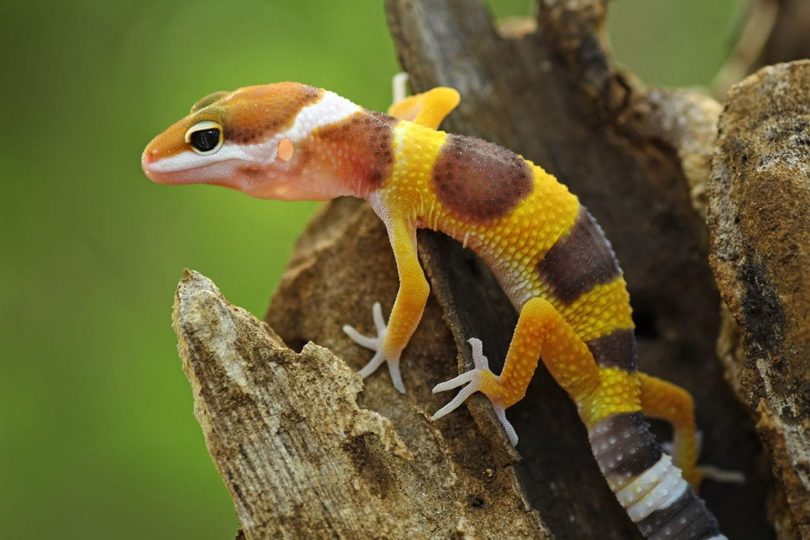
MBD stems from vitamin D3 and calcium deficiency, two vital nutrients for bone and egg creation. Metabolic Bone Disease is life-threatening if not caught early, but it can be easily avoided with proper nutrition and lighting.
9. Gastroenteritis
Gastroenteritis relates to an infection in the gut, specifically the stomach and intestines. This can be from numerous factors, like parasites and sand impaction. This can quickly become a life-threatening problem, so it’s wise to take your leopard gecko to an exotic vet if you notice the Signs.
10. Pneumonia
Pneumonia is a respiratory tract infection caused by bacteria in the lungs. Respiratory infections are common but are equally serious. Usually, a cold enclosure with high humidity is the main reason leopard geckos catch pneumonia. Other causes can be poor ventilation, unsanitary conditions, poor diet, and other underlying illnesses, like vitamin A deficiency.
Keeping Your Gecko Happy and Healthy
So, how does a gecko owner avoid the nightmare of dealing with a sick reptile?
Here’s the good news: most of the diseases we just mentioned can easily be avoided with a quality diet and environment. Let’s explore this further.
Diet Dominates Disease
With any creature, diet is of the utmost importance for health and vitality. Geckos can be tricky because they only eat live insects and refuse dead insects or any plant matter.
For that reason, it’s crucial to source your gecko’s food from a reputable pet store. When purchasing insects, ensure you buy well-fed ones. A well-fed insect will pass on vital nutrients and minerals to your gecko.
Variety is also key. Offer your gecko an array of insects, like crickets, worms, silkworms, waxworms, and roaches. Go a step further and dust the crickets with calcium powder twice weekly to ensure strong, healthy bones and proper egg laying.
With any creature, there are some dos and don’ts with what you can offer as food. Under no circumstances can leopard geckos eat bugs that glow, such as fireflies or lightning bugs. The chemical that makes the insect glow is toxic to leopard geckos. You also want to avoid wild bugs since pesticides can poison them.
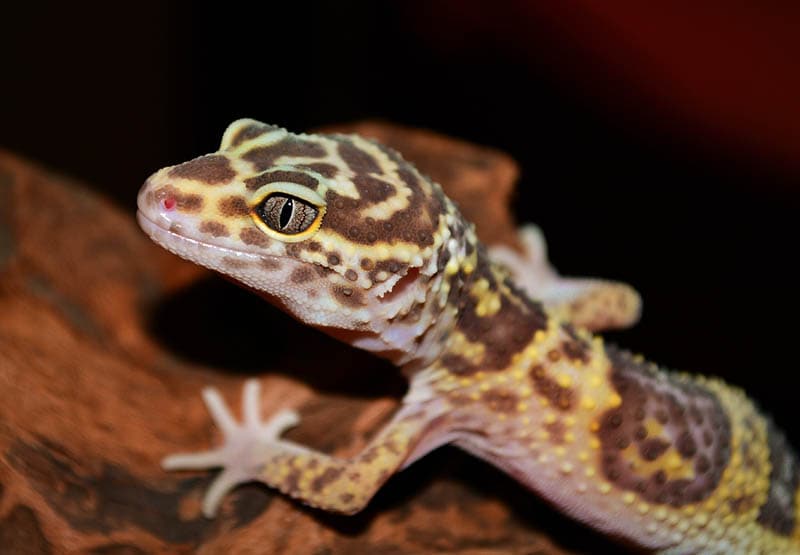
Age Matters with Leopard Geckos
Feeding your gecko the right amount of food will help it receive nutrients and avoid disease. You don’t want to overfeed or underfeed your leopard gecko, so understanding your gecko’s age can help.
Adult geckos can feed once every other day for about 15 to 20 minutes. During this time, they can eat however much they want to their heart’s content. Offer insects no larger than the space between the gecko’s eyes. Otherwise, the insect won’t digest properly.
In contrast, young leopard geckos require daily feeding. Hatchlings can eat a bug about ⅜ inches long, and juvenile geckos can eat bugs about ¼ inch long.
House Requirements
A proper habitat includes light, humidity, warmth, and good ventilation.
Light

Geckos are nocturnal, so avoid using bright lights at all costs. Instead, opt for black heat lamps and red lamps.
The lighting should mimic the natural light cycle your gecko would experience in the wild. Geckos need about 14 hours of light during the summer and 10 hours of “nighttime.” During the winter, change the lighting to 12 hours for the morning and 12 hours for the night.
Humidity & Warmth
Humidity is vital for a gecko’s well-being. Too much or too little humidity can cause skin issues and respiratory infections, so you want to ensure you have it just right. Likewise, a cold gecko will refuse food and could eventually become nutrient deficient.
Ideally, a humidity level between 30% to 40% is best, with a toasty enclosure between 77 to 90 degrees Fahrenheit (25 to 32 degrees Celsius). Nighttime temperatures shouldn’t drop below 65 degrees Fahrenheit (18.3 degrees Celsius). The entire chamber doesn’t need to be kept at a consistent temperature. A little variety is good as long as it’s within the ideal temperature range. Experienced gecko owners will have a warm and cool side of the enclosure.
Geckos also need moist boxes to help with shedding. To create a damp environment, you can use a moist substrate like peat moss, damp soil, or sphagnum moss.
Ventilation
To achieve proper ventilation, add a mesh covering the entire lid or do something more active and install an electronic ventilator. Either method is acceptable as long as the gecko has good air quality.
Substrate
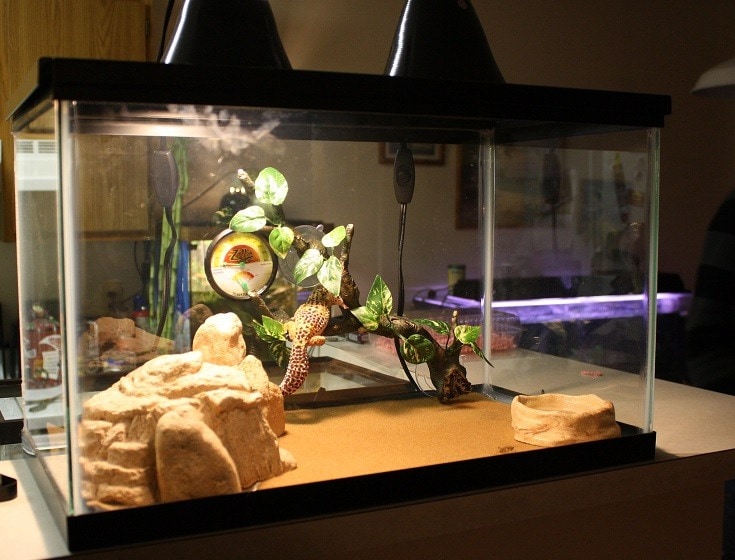
The substrate is the bedding at the bottom of the tank, and it’s more important than you’d think. Leopard geckos spend most of their time on the ground, meaning they will walk, run, and eat on the substrate provided to them. Females will even lay their eggs on the substrate.
The wrong substrate can affect your gecko’s life because your gecko might ingest it, or your female could refuse to lay eggs on it.
Sand, wood chips, quarts, walnut shells, and bark are all substrates to avoid since these are outside the gecko’s natural environment and can cause harm.
Conclusion
Leopard geckos are indeed prone to certain diseases. Still, a solid diet and enclosure setup can avoid most of these ailments. Take the time and money to offer your leopard gecko the best food and living space, and your gecko will thrive.
Featured Image Credit: torstensimon, pixabay




